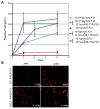Development of Novel Recombinant AAV Vectors and Strategies for the Potential Gene Therapy of Hemophilia
- PMID: 23264889
- PMCID: PMC3526190
- DOI: 10.4172/2157-7412.S1-008
Development of Novel Recombinant AAV Vectors and Strategies for the Potential Gene Therapy of Hemophilia
Abstract
Recombinant vectors based on a non-pathogenic human parvovirus, the adeno-associated virus (AAV), have gained attention as a potentially safe and useful alternative to the more commonly used retroviral and adenoviral vectors. AAV vectors are currently in use in Phase I/II clinical trials for gene therapy of a number of diseases such as cystic fibrosis, α-1 antitrypsin deficiency, muscular dystrophy, Batten's disease, and Parkinson's disease, and have shown efficacy in patients with Leber's congenital amaurosis, and hemophilia B. For patients with hemophilia B, however, relatively large vector doses are needed to achieve therapeutic benefits. Large vector doses also trigger an immune response as significant fraction of the vectors fails to traffic efficiently to the nucleus, and is targeted for degradation by the host cell proteasome machinery. With a better understanding of the various steps in the life cycle of AAV vectors, strategies leading to the development of novel AAV vectors that are capable of high-efficiency transduction at lower doses are needed. In this review, we summarize our strategies to develop novel AAV vectors for the potential gene therapy of both hemophilia B and hemophilia A, based on our recent studies on the basic molecular biology of AAV. These strategies, including the development of novel AAV vectors by site-directed mutagenesis of critical surface-exposed tyrosine residues on AAV2 capsids to circumvent the ubiquitination step and the use of different AAV serotypes and self-complementary (sc) AAV2 vectors, and their use as helper vectors to circumvent the obstacles of second-strand DNA synthesis of single-stranded (ss) AAV, should dramatically accelerate the progress towards the potential gene therapy of both hemophilia A and hemophilia B.
Figures



Similar articles
-
Next generation of adeno-associated virus 2 vectors: point mutations in tyrosines lead to high-efficiency transduction at lower doses.Proc Natl Acad Sci U S A. 2008 Jun 3;105(22):7827-32. doi: 10.1073/pnas.0802866105. Epub 2008 May 29. Proc Natl Acad Sci U S A. 2008. PMID: 18511559 Free PMC article.
-
Evaluation of engineered AAV capsids for hepatic factor IX gene transfer in murine and canine models.J Transl Med. 2017 May 1;15(1):94. doi: 10.1186/s12967-017-1200-1. J Transl Med. 2017. PMID: 28460646 Free PMC article.
-
Optimized adeno-associated virus (AAV)-protein phosphatase-5 helper viruses for efficient liver transduction by single-stranded AAV vectors: therapeutic expression of factor IX at reduced vector doses.Hum Gene Ther. 2010 Mar;21(3):271-83. doi: 10.1089/hum.2009.100. Hum Gene Ther. 2010. PMID: 19788390 Free PMC article.
-
Developing immunologically inert adeno-associated virus (AAV) vectors for gene therapy: possibilities and limitations.Curr Pharm Biotechnol. 2014;14(12):1072-82. doi: 10.2174/1389201015666140327141710. Curr Pharm Biotechnol. 2014. PMID: 24678652 Review.
-
Preclinical gene therapy studies for hemophilia using adeno-associated virus (AAV) vectors.Semin Thromb Hemost. 2004 Apr;30(2):161-71. doi: 10.1055/s-2004-825630. Semin Thromb Hemost. 2004. PMID: 15118928 Review.
Cited by
-
Single point mutation in adeno-associated viral vectors -DJ capsid leads to improvement for gene delivery in vivo.BMC Biotechnol. 2016 Jan 5;16:1. doi: 10.1186/s12896-015-0230-0. BMC Biotechnol. 2016. PMID: 26729248 Free PMC article.
-
Scalable downstream strategies for purification of recombinant adeno- associated virus vectors in light of the properties.Curr Pharm Biotechnol. 2015;16(8):684-95. doi: 10.2174/1389201016666150505122228. Curr Pharm Biotechnol. 2015. PMID: 25941887 Free PMC article. Review.
-
The potential of adeno-associated viral vectors for gene delivery to muscle tissue.Expert Opin Drug Deliv. 2014 Mar;11(3):345-364. doi: 10.1517/17425247.2014.871258. Epub 2014 Jan 3. Expert Opin Drug Deliv. 2014. PMID: 24386892 Free PMC article. Review.
-
Anti-CD20 as the B-Cell Targeting Agent in a Combined Therapy to Modulate Anti-Factor VIII Immune Responses in Hemophilia a Inhibitor Mice.Front Immunol. 2014 Jan 6;4:502. doi: 10.3389/fimmu.2013.00502. eCollection 2014 Jan 6. Front Immunol. 2014. PMID: 24432019 Free PMC article.
-
Bone-targeting AAV-mediated silencing of Schnurri-3 prevents bone loss in osteoporosis.Nat Commun. 2019 Jul 4;10(1):2958. doi: 10.1038/s41467-019-10809-6. Nat Commun. 2019. PMID: 31273195 Free PMC article.
References
-
- Berns KI, Bohenzky RA. Adeno-associated viruses: an update. Adv Virus Res. 1987;32:243–306. - PubMed
-
- Muzyczka N, Berns K. In Fields Virology. Philadelphia, PA: Lippincott, Williams and Wilkins; 2001.
-
- Pattison J. Parvovirus and human disease. Boca Raton: CRC Press; 1988.
Grants and funding
LinkOut - more resources
Full Text Sources
Other Literature Sources
